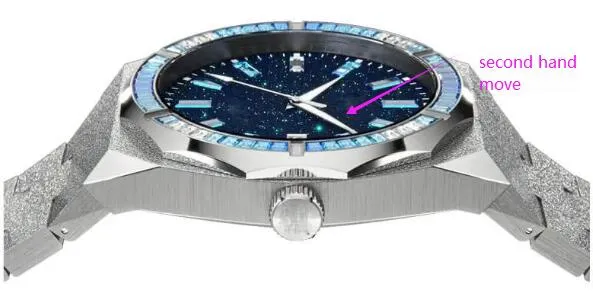When looking at his watch, how can I tell if it’s a quartz or automatic watch? I’m trying to figure it out but I can’t open it to check. Is there any way to tell the difference?
If you buy a watch and want to see whether it has a mechanical or quartz movement, then you can do so by these methods, Flat your watches on your hand and check:
Way 1: Look at the second-hand
The most noticeable difference is in the movement of the second hand.

- If the second-hand moves step by step, jumping from one mark to the next in distinct intervals, the watch likely has a quartz movement. Quartz watches are powered by a battery, which controls a small quartz crystal. The crystal vibrates at a very precise frequency, typically 32,768 times per second, allowing the watch to keep accurate time. This ticking motion is the result of the quartz movement’s ability to count these vibrations, creating the classic ticking sound as the second-hand jumps forward once per second.
- If the second-hand moves in a smooth, continuous sweeping motion, it’s likely an automatic watch (or any mechanical movement). Mechanical watches rely on a complex system of gears and springs to power the movement. Unlike quartz watches, mechanical watches have a second hand that glides around the dial in a smooth motion, as the stored energy from the wound mainspring is released gradually to drive the movement. This continuous motion is one of the most defining features of a mechanical watch.
Way 2: Listen for ticking
Another tell-tale sign of a quartz movement is the sound.
- If you hear a distinct ticking sound, the watch is probably quartz.
- Automatic watches typically don’t make a ticking sound as their second-hand moves smoothly.

The ticking sound is a clear giveaway that your watch uses a quartz movement, as the battery power drives the mechanism in distinct intervals, creating the ticking rhythm.
Way 3: Check other hand movements
In addition to the second hand, you can also observe the movement of the hour and minute hands.
- On a mechanical watch, these hands tend to move in a more fluid and precise manner, thanks to the continuous power provided by the mainspring and gear system.
- In contrast, quartz watches typically have slightly less smooth movement for the hour and minute hands because the battery drives them in a less fluid manner than mechanical gears.
Way 4: Check the Crown
You can tell if a watch is quartz or automatic by adjusting the crown in the following ways:

- Pull the Crown Out:
- If the watch has a three-position crown, pull it out to the second position (usually the middle position).
- If turning the crown causes the second hand to move in distinct ticks or steps (one tick per second), the watch is likely quartz. This is typical behavior for quartz watches as they tick once per second.
- Winding the Watch:
- If you pull the crown out to the first position and turn it, you may feel resistance. If the watch winds (and may start moving if it was stopped), it suggests that it is an automatic or manual mechanical watch.
- If the crown can be turned but there’s no noticeable effect on the second hand (it doesn’t start moving), it may indicate a quartz movement.
- Check the Crown Positions:
- In automatic watches, adjusting the crown often affects the time and date settings but does not typically cause the second hand to tick in a pronounced manner.
- In quartz watches, especially if it’s not running, pulling the crown may start the second hand ticking in a stepwise manner.
Way 5: Open the watch and Check the batteries
If you can open the watches, You can open the case back.
- If there are batties( coin battery) in the watch, it is a Quartz watch,
- If no batteries, it is a Mechanical watch
- watch back battery
Way 6: Check Case Back ( Not 100% sure)
If you can just check the case back, don’t need to open it.

- Transparent Case Back:
- If the watch has a transparent case back, you can usually see the inner workings of the movement. If you observe intricate gears, springs, and other mechanical components, it is likely a mechanical watch (automatic or manual). Mechanical watches often showcase their craftsmanship through visible movements.
- Solid Case Back:
- If the case back is solid and non-transparent, the watch may be a quartz watch. Many quartz watches are designed with plastic parts, which can make the inner workings less visually appealing. Therefore, designers often opt for a solid case back to maintain an aesthetic look.
Way 7: Weight and Feel ( Not 100% sure)
- Overall Weight: Automatic watches typically have a heavier and more substantial feel due to the materials and components used in their construction. Quartz watches are often lighter
- Balance: The weight distribution may also feel different; mechanical watches usually feel balanced, while quartz watches might feel lighter in hand.
Way 8: Case Back Materials and Design ( Not 100% sure)
- Material: Many quartz watches feature case backs made of simple or lightweight materials, which can be less durable than the metals typically used in mechanical watches. If you notice a lightweight or thin, it might lean towards being quartz.
- Design Aesthetics: Automatic watches often have more elaborate case backs, sometimes engraved with designs or branding that reflect the craftsmanship and heritage of the watch. such as embossed case back, thick, and 3d view. This attention to detail is usually absent in many quartz models.
high stainless steel case1
Way 9: Look for the label
Sometimes, the case back or watch dial will have markings that indicate the type of movement. Look for words like “Automatic,” “Mechanical,” or “Quartz.” If you see “Quartz,” it confirms that the watch is a quartz movement.









